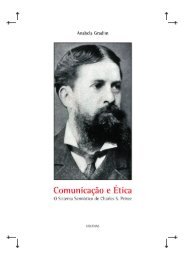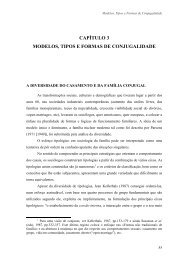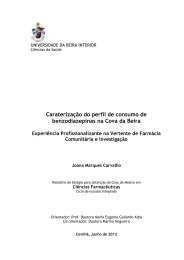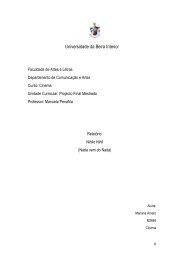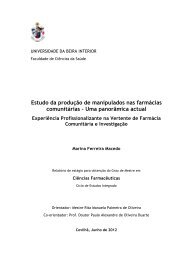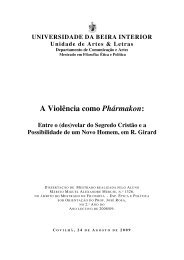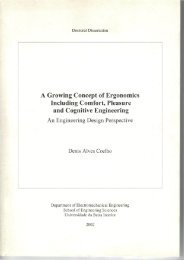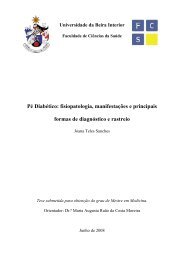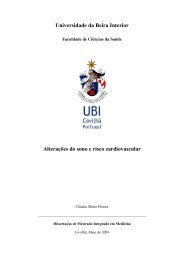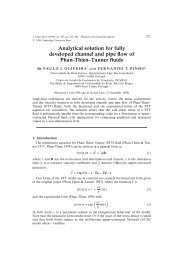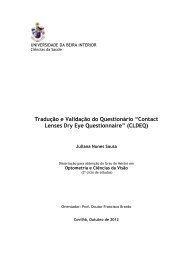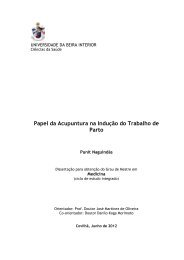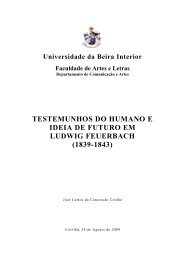Tese_Tânia Vieira.pdf - Ubi Thesis
Tese_Tânia Vieira.pdf - Ubi Thesis
Tese_Tânia Vieira.pdf - Ubi Thesis
Create successful ePaper yourself
Turn your PDF publications into a flip-book with our unique Google optimized e-Paper software.
Chapter II – Materials and Methods<br />
2. Materials and Methods<br />
2.1. Materials<br />
Human fibroblasts cells (Normal Human Dermal Fibroblasts adult, criopreserved cells) were<br />
purchased from PromoCell (Spain), bacterial strain Escherichia coli DH5α (ATCC 68233) was<br />
purchased from ATCC (United States).<br />
Fetal bovine serum (FBS) was purchased from Biochrom AG (Berlin, Germany). 3-(4,5-<br />
dimethylthiazol-2-yl)-5-(3-carboxymethoxyphenyl)-2-(4-sulfophenyl)-2H-tetrazolium reagent<br />
(MTS) and electron coupling reagent phenazine methosulfate (PMS) were purchased from<br />
Promega. Amphotericin B, ascorbic acid (C 6 H 8 O 6 ), Dulbecco’s Modified Eagle Medium-F12<br />
(DMEM), ethanol (EtOH), high molecular weight chitosan, L-glutamine, LuriaBertani (LB) Broth,<br />
penicillin G, phosphate-buffered saline (PBS), rezazurin sodium salt, sodium borohydride<br />
(NaBH 4 ), sodium citrate (Na 3 C 6 H 5 O 7 ), and trypsin were purchased from Sigma. Dextran sulfate<br />
500,000 was purchased from Amresco. AgNO 3 was purchased from Panreac (Spain). LB agar was<br />
purchased from Pronadise.<br />
2.2. Methods<br />
2.2.1. Preparation of silver nanoparticles<br />
The AgNPs were produced based on the method previously developed by Mafune and<br />
collaborators (Mafune et al. 2000). Briefly, the procedure consists on the rapid injection of 0.5<br />
ml of NaBH 4 (10 mM) into an aqueous solution, with continuous stirring, containing 0.5 ml of<br />
AgNO 3 (0.1 M, 0.01 M, and 0.001 M) and 20 ml of Na 3 C 6 H 5 O 7 (0.001 M). The resultant solution was<br />
stirred for 1 h and aged for 2 h. Moreover, the NaBH 4 solution was replaced by C 6 H 8 O 6 (10 mM)<br />
and this component was added to a 0.01 M AgNO 3 solution. The resulting nanoparticles were<br />
washed three times with distilled water and centrifuged at 75000 g, during 30 min.<br />
Subsequently, a dried powder of particles was obtained by freeze-drying the particles overnight.<br />
2.2.2. Preparation of the Chitosan/Dextran nanoparticles<br />
Chitosan/dextran nanoparticles were prepared by the ionotropic gelation of chitosan and<br />
dextran as described before by Chen and colleagues (Chen et al. 2007). A 0.1 % (m/v) chitosan<br />
solution was prepared by dissolving chitosan in aqueous acetic acid 0.2 % (v/v) and the pH was<br />
adjusted to 3.5. A 0.1 % (m/v) dextran solution was prepared by dissolving the dextran in water.<br />
21



